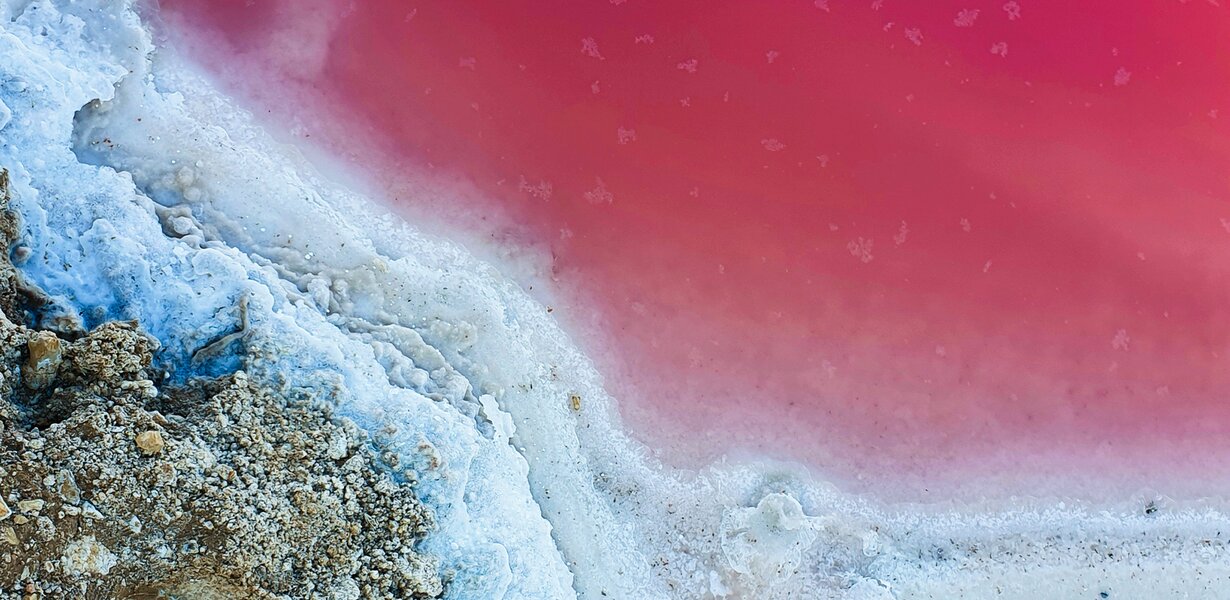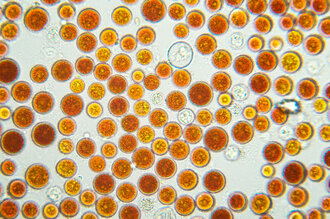Astaxanthin is a reddish plant pigment that is considered the main carotenoid of marine life. Not only does the sea antioxidant help plants and animals to survive extreme situations, it also makes a difference for us humans. This means that the heart, eyes, immune system and skin benefit from astaxanthin’s natural strength, not to mention sporty ambitious individuals. Find out here what it is, what it can do and how to use it.
Astaxanthin – what is it?
Astaxanthin is a red botanical dye that chemically belongs to the carotenoid family. Formed primarily by plankton and algae, the fat-soluble antioxidant enters the marine world via the food chain and gives water dwellers such as crabs, lobster, shrimps or wild salmon their characteristic red to pink-red colour. Moreover, flamingos would also look pretty pale without their favourite food – small crabs loaded with astaxanthin.
The most important natural source of astaxanthin is green algae Haematococcus pluvialis, known as blood algae. In the normal green state, the algae begins to store astaxanthin in its cells in stressful situations (e.g. high UV radiation, nutrient/water deficiency, extreme heat) and turns red as a result. This protective mechanism allows the algae to survive life-threatening periods for years until the environmental conditions improve.

Animal life also benefits from consumed astaxanthin. Salmon, for example, are supported by the plant dye in their powerful marathon upriver to their spawning pools. Astaxanthin, which is excreted from the fatty tissue under long-term stress, ensures more rapid muscle regeneration in animals.
Astaxanthin benefits: Is astaxanthin healthy?
Astaxanthin not only strengthens the animal and plant world, but people too benefit from this plant dye. It has earned its sobriquet of “red diamond” from the fact that it is considered one of the strongest natural antioxidants. According to comparative studies (e.g.), astaxanthin is 6,000 times stronger than vitamin C, 770 times stronger than coenzyme Q10 and 100 times stronger than vitamin E.
Many of its positive health effects are based on this remarkable antioxidant potential. After all, many symptoms, aging processes and metabolic disorders can be associated with an increased amount of oxidative stress. Other benefits described for astaxanthin are anti-inflammatory, neuroprotective and antimicrobial.
Effect: What is astaxanthin good for and what does it do in the body?
Astaxanthin effectively defuses free radicals through its antioxidant superpowers. This property makes it not only an important supporter of our health, but also a potential phytotherapeutic agent for symptoms associated with increased oxidative stress. Based on current studies, we have summarised the most promising areas of application below:
Astaxanthin benefits: for natural protection against sun & premature skin ageing
Astaxanthin benefits for skin: Skin is not only our largest organ, it is also the most important line of defence against external damage. As such, it is permanently exposed to various environmental factors – whether UV radiation, environmental toxins, mechanical stimuli or chemical substances. Many of these influences are associated with increased free radical formation, while free radicals are thought to be the leading factor in premature aging of the skin due to damage to our skin structures.
Due to its strong antioxidant properties, astaxanthin acts as a natural sunscreen. It can reduce the negative effects of excessive UV radiation and counteract inflammation (e.g. sunburn). Of course, it does not replace sunscreen products, but can make them more meaningful and even more effective.
Astaxanthin is also thought to be effective in reducing the visible effects of premature skin ageing. Particularly worth mentioning here are two Japanese studies in which the intake of astaxanthin led to an improvement in the eye lines and a reduction in the size of age spots in the cheek area. Other before and after astaxanthin effects were recorded: skin texture, skin moisture and skin elasticity also improved. The skin-smoothing effect of astaxanthin can be attributed to several mechanisms. Astaxanthin not only protects skin collagen from oxidative damage, it also inhibits collagen-degrading enzymes that are activated during stress and also stimulates the skin’s own collagen synthesis.
Eyes: Astaxanthin as inner sunglasses
Not only do our eyes capture (at least optically) the most beautiful moments in our lives, they are also particularly open to oxidative stress due to the UV rays they capture. With advancing age, certain eye disorders can occur that can be attributed to oxidative damage.
It has been known for some time that the two carotenoids lutein and zeaxanthin can have a positive effect on eye health. However, astaxanthin has now also become a focus of attention for preventing eye problems. Astaxanthin not only has a high antioxidative effect, it is also able to overcome the blood-retina barrier – a selectively permeable barrier between the retina (retinal) and the vessels supplying the retina – and to lodge itself in the retina. Studies have also shown that astaxanthin helps to maintain better acuity.
A study from 2009 investigated whether and how taking astaxanthin affects the onset of presbyopia. The results were clear: In a majority of study participants, pupil constriction (convergence insufficiency) improved significantly after a visual stimulus, which is useful when focusing on close objects. Targeted intake also had a positive effect on other symptoms, such as overworked eyes, blurred vision or shoulder and neck tension.
Astaxanthin can also be useful for digital eye exposure (computer vision syndrome). Typical symptoms of this novel syndrome begin with headaches and sleep disorders and range to exhaustion, red eyes, dizziness or even blurred vision. Astaxanthin is able to counteract the effects of daily digital life. The carotenoid thus reduced the refocusing time of the eye by 46% and improved the accommodation (= the ability of the eye to actively adjust visual acuity at different distances) by 27%.
Astaxanthin as a natural advocate of our cardiovascular health
Both chronic inflammatory processes and increased oxidative stress are significantly involved in the development of cardiovascular diseases – both processes that can be positively influenced by astaxanthin according to the current study situation.
Meanwhile, there is increasing evidence that astaxanthin could actually also have a cardioprotective effect in practice. For example, studies not only indicate that astaxanthin could counteract the oxidation of “bad cholesterol” (LDL), but animal studies also suggest a possible antihypertensive effect in the case of hypertension (high blood pressure). In addition, astaxanthin has been shown to have a lower blood sugar-lowering effect in a meta-analysis – another beneficial effect in terms of cardiovascular protection.
Astaxanthin for high sports achievements
Astaxanthin is considered a secret tip among ambitious leisure and competitive sports enthusiasts. Intensive physical exertion is always associated with increased oxygen consumption, which can lead to increased formation of reactive oxygen species (free radicals). If this results in an imbalance in the oxidative equilibrium, structural damage can occur, which can be accompanied by an increased risk of injury, longer regeneration times, chronic muscle fatigue and increased susceptibility to infections or inflammation.
Taking astaxanthin during training helps to protect the organism from oxidative damage during intensive training periods and competitions, to reduce muscle damage and to shorten recovery time. Studies also suggest that the targeted intake of the super-antioxidant improves both exercise performance and muscle system recovery. For example, a Swedish double-blind study with 40 healthy male students showed that taking 4 mg astaxanthin for six months had benefits on muscle endurance and strength.
Astaxanthin for a fit immune system
The role of astaxanthin in supporting our immune system is less well known. Due to the high content of polyunsaturated fatty acids in their plasma membrane, immune cells react particularly sensitively to oxidative stress. At the same time, immune cells can also produce free radicals themselves (reactive oxygen species). In the event of a disrupted oxidative balance (e.g. as a result of a viral disease), antioxidants are able to intervene in a regulating manner and protect the membranes of the immune cells from destruction.
A randomised placebo-controlled study with 42 women showed how effective astaxanthin can be in the immune system. They received either 2 mg astaxanthin, 8 mg astaxanthin or a placebo for 8 weeks. Astaxanthin not only improved the activity of certain immune cells, but also had a positive effect on the inflammatory response.
Astaxanthin as a dietary supplement
Dosage forms: Capsules, tablets, drops, powder and more
Those who want to take astaxanthin as a food supplement are spoilt for choice. The marine superantioxidant is now available in many different forms on the market. The most common are capsules, tablets, drops and powder.
For many people, capsules or tablets are chosen. These are easy to dose, tasteless, hygienic and practical to take. While tablets usually require production-related additives, capsule products often do not contain technical excipients.
Astaxanthin preparations in drops or powder form are suitable for people who like taste or have difficulty swallowing. However, a look at the list of additives is a must, especially for these types of administration. Here, the fewer additives, the better, should be the rule of thimb.
Bioavailability of astaxanthin food supplements
The bioavailability of astaxanthin from dietary supplements depends on numerous factors. Concomitant intake of the astaxanthin preparation with a fat-containing meal, for example, has an advantageous effect. This can increase the bioavailability of the astaxanthin contained 2 to 4 times.
The raw material also influences bioavailability. Particularly recommended are products based on the blood algae Haematococcus pluvialis. The astaxanthin obtained from this is more stable due to its esterification – adhesion of natural fatty acids at the ends of the molecule – and is more easily absorbed by the body. Synthetic astaxanthin is usually unesterified and can therefore easily oxidise.
Incidentally, smoking also has a negative effect. Smoking not only accelerates the breakdown of astaxanthin, it also greatly reduces its bioavailability.
Vegan quality astaxanthin from Austria by BIOGENA
Did you know that the astaxanthin (astafit®) used by BIOGENA is a genuine Styrian? This is because east of the "Grüne Mark", the green algae Haematococcus pluvialis grows in a sealed agricultural system, from which the red super antioxidant astaxanthin is finally obtained in the highest quality (astafit®).
Astaxanthin “Made in Austria” – from our region? We don’t just think that’s amazing – astafit® really is amazing literally! While synthetically produced astaxanthin loses enormous effect and function, astafit® contains 100% natural astaxanthin, which is also purely vegan due to its production from green algae. Only in this way is astaxanthin fully effective and guaranteed in uncompromising quality for BIOGENA.
BIOGENA Astaxanthin products – and their other ingredients
BIOGENA offers three high-quality astaxanthin products that can be purchased both in the BIOGENA premium stores and in the online shop. For targeted astaxanthin refuelling, our astaxanthin 4 mg is the first choice because it consists of 100% natural premium astaxanthin from the Austrian brand manufacturer astafit®. The natural carotenoid dissolved here in sunflower oil is airtight, keeping the active ingredient available for longer and ensuring maximum bioavailability. In fit@work® IMMUN Astaxanthin, the sea antioxidant has been combined with the immune nutrients vitamins C and D, equipping your defences for their daily challenges. People who don’t just want to stay young at heart will love what our spermidine CellImmun® is all about. This product combines the concentrated powers of spermidine, astaxanthin and zinc.
Comparison of astaxanthin and other nutrients
Take OPC and astaxanthin together?
Can astaxanthin be combined with other botanicals/extracts, such as OPC, resveratrol, lycopene or curcumin? Many users who are uncertain about the concomitant use of astaxanthin with other plant preparations ask themselves this question. This question can be answered with a resounding yes. There is nothing wrong with taking astaxanthin together with other phytopreparations – in fact, it’s quite the opposite! A combination can even be very beneficial, since other botanicals can enhance the effects of astaxanthin or complement another spectrum of action. Incidentally, the same applies to other micronutrients such as vitamin A, vitamin C, vitamin D, vitamin E, coenzyme Q10 or alpha lipoic acid.
Zeaxanthin, lutein and astaxanthin
Astaxanthin, lutein and zeaxanthin are carotenoids, all of which belong to the group of xanthophyllene. While astaxanthin has a reddish colour, lutein and zeaxanthin are orange yellow. The latter two botanicals are found mainly in green vegetables such as kale, broccoli or parsley. In these vegetables, their colour is overlaid with green chlorophyll.
In the human body, zeaxanthin and lutein are found in high concentrations in the retina of the eye to protect the eyes from harmful blue light and oxidative stress, equivalent to inner sunglasses. It is now known that not only can lutein and zeaxanthin counteract age-related eye diseases, but also that targeted supplementation of astaxanthin has an “eye protection effect”.
Astaxanthin and collagen
In the beauty world, collagen is currently a really hot topic. This beauty nutrient is said to reduce the appearance of wrinkles and improve the elasticity and tone of the skin. Astaxanthin can help collagen in its aim to protect smooth skin by fighting wrinkles. Astaxanthin not only protects skin collagen from oxidative damage, it also inhibits collagen-degrading enzymes that are activated during stress and also stimulates the skin’s own collagen synthesis. So astaxanthin and collagen pull together to reduce lines and wrinkles.
Astaxanthin and quercetin
Unlike astaxanthin, quercetin, is not a carotenoid , but belongs to the flavonoid group. The lemon yellow plant pigment is found in countless plant-based foods in the diet. Particularly high concentrations are found in capers, herbs and onions as well as in green vegetables, apples and berries. Quercetin also has a remarkable antioxidant potential, but cannot compete with the super antioxidant astaxanthin. However, which plant substance should ultimately be given priority does not depend solely on its antioxidant potential, but on the health benefit that is expected from its intake. While astaxanthin is recommended in its study situation primarily for protection against age-related eye damage, for improvement of the skin (wrinkle reduction, increase in skin elasticity and skin moisture) and in the prevention and treatment of cardiovascular diseases, the use of quercetin is particularly promising in the area of allergies and viral respiratory diseases. Incidentally, both botanicals are suitable as training supplements for high achievements in sport.
Astaxanthin vs. Ashwagandha
Astaxanthin and Ashwagandha – which sound similar, are quite different in reality. While astaxanthin is a plant component of carotenoids, Ashwagandha is an Ayurvedic plant from the nightshade family.
Astaxanthin and Ashwagandha also differ completely from each other in their spectrum of action. As already mentioned above, astaxanthin is particularly suitable for protection against age-related eye disorders and premature skin ageing, as well as for supporting sporting performance and the body's own defences.
Ashwagandha, on the other hand, is particularly appreciated for its adaptogenic properties. Adaptogens help our body to cope better with stress. In addition, Ashwagandha is also a secret tip for people with trouble falling asleep. It is not for nothing that it is also called the "sleep berry" in German.
Astaxanthin dosage & intake - our recommendation
Time: When to take astaxanthin?
Astaxanthin can be taken at any time of day or night. However, it is best to choose the time of administration in such a way that it is integrated into the individual daily routine so it is not forgotten.
Recommended use: What is the best way to take astaxanthin?
As a fat-soluble antioxidant, astaxanthin should ideally be taken with a meal that contains some fat. As a result, astaxanthin can be absorbed into the body 2 to 4-times more effectively.
Daily dose: How much astaxanthin per day?
The efficacy of an astaxanthin preparation largely depends on the correct dosage, which can vary depending on the therapeutic indication. Experience has shown that most recommendations are in a dosage range of 4 – 8 mg astaxanthin daily. However, your doctor will be happy to advise you in order to select the right dosage for you.
Astaxanthin absorption
Since astaxanthin is fat-soluble, the super antioxidant should always be combined with a fat-containing meal. The fat in the carotenoid helps to ensure optimal absorption of the carotenoid by the body.
When does astaxanthin work?
When one can expect an effect from taking astaxanthin depends on several factors. Above all, the reason for intake as well as the dosage and the individual response to the antioxidant play a major role.
How long should you take astaxanthin?
How long to take astaxanthin depends on the respective reason for taking it and on the dosage. It is best to consult your doctor regarding the duration of administration. Your doctor can advise you best in your individual case. In principle, however, there is nothing that argues against long-term intake at the appropriate dose.
Astaxanthin if you wish to have children
It has long been known from the animal world that the consumption of astaxanthin-containing food can have a beneficial effect on the fertility of "consumers". According to initial studies, couples who wish to have children could also benefit from this fertility-promoting effect.
A randomised, placebo-controlled double-blind study showed that targeted administration of 16 mg astaxanthin daily led to an increase in sperm concentration and quality. This effect was not only in theory, but also in practice. After all, over half (54.5%) of the partners of the astaxanthin group became pregnant during the study period. In comparison, it was only 10.5% in the placebo group.
Astaxanthin during pregnancy & lactation
There is no scientific data on the targeted intake of astaxanthin during pregnancy and lactation. For this reason, expectant and breastfeeding mothers should refrain from taking astaxanthin during these special life phases.
Astaxanthin in menopause
Not only young women, but also women in the menopause can benefit from taking astaxanthin. After all, the botanical dye has been proven to combat the various challenges that women can face in their mid-life. This includes a deterioration in eye health and ageing of the skin. In addition, astaxanthin may have a positive effect on cardiovascular parameters (e.g. high blood pressure, oxidised LDL, increased blood sugar) and chronic inflammation.
Astaxanthin deficiency?
Whether for heart or eye protection, sports achievements or beautiful skin – astaxanthin is without a doubt a valuable choice. However, those who do not consume fish or supplement with astaxanthin do not have to fear an astaxanthin deficiency, because nutrient deficiencies only occur in essential (= vital) nutrients.
Conclusion
Conclusion: Astaxanthin is one of the world’s strongest natural antioxidants. Its antioxidant and anti-inflammatory power makes the “red diamond” an important supporter of our health and a potent phytotherapeutic agent for a range of different physical topics. Its effect on age-related eye disorders and premature skin ageing as well as its effect as a natural sunscreen is considered particularly promising. In addition, astaxanthin also equips our defences and stimulates our sporting performance.
Frequently asked questions about astaxanthin
Astaxanthin is one of the world’s strongest natural antioxidants.
The daily dosage of astaxanthin is generally between 4-8 mg.
Astaxanthin is widely used as a super antioxidant and natural anti-inflammatory in phytotherapy. In terms of the study, the vegetable dye is documented above all as an active substance against age-related eye disease, premature skin ageing, cardiovascular diseases, for immunomodulation and to stimulate sporting performance.
Initial studies suggest that astaxanthin may be beneficial for certain psychological problems such as depression or sleep disorders.
References - Astaxanthin studies
Mikronährstoffcoach. 2024. https://www.mikronaehrstoffcoach.com/de/at/mikronaehrstoffe/micronutrient.astaxanthin.html#:~:text=Die%20Bioverf%C3%BCgbarkeit%20von%20Astaxanthin%20h%C3%A4ngt,also%20ber%C3%BCcksichtigt%20werden%20(7). Zugriff: 4.4.2024.
Fakhri, S. et al. 2018. Astaxanthin: A Mechanistic Review on Its Biological Activities and Health Benefits. Pharmacol Res. 136:1-20.
Ambati, R. R. et al. 2014. Astaxanthin: sources, extraction, stability, biological activities and its commercial applications – a review. Mar Drugs. 12(1):128–52.
Nishida, Y. et al. 2007. Quenching Activities of Common Hydrophilic and Lipophilic Antioxidants against Singlet Oxygen Using Chemiluminescence Detection System. Carotenoid Sci. 11:16–20.
Beutner, S. et al. 2001. Quantitative assessment of antioxidant properties of natural colorants and phytochemicals: carotenoids, flavonoids, phenols and indigoids. The role of β-carotene in antioxidant functions. J Sci Food Agric. 81(6):559–68.
Fuji Chemical Industry Co., Ltd. 2009. Notification of GRAS Determination for Haematococcus pluvialis extract characterized by component astaxanthin esters (of common edible fatty acids)
Bjerkeng, B. et al. 2000. Astaxanthin and its metabolites idoxanthin and crustaxanthin in flesh, skin, and gonads of sexually immature and maturing Arctic charr (Salvelinus alpinus (L.)). Comp Biochem Physiol B. Biochem Mol Biol. 125(3):395–404.
Okada, Y. et al. 2009. Bioavailability of astaxanthin in Haematococcus algal extract: the effects of timing of diet and smoking habits. Biosci Biotechnol Biochem. 73(9):1928–32.
FDA. 2000. Technical Report (Aquaresearch Inc.) Haematococcus Pluvialis and Astaxanthin Safety For Human Consumption
Zhou, Q. et al. 2015. The effect of various antioxidants on the degradation of O/W microemulsions containing esterifed astaxanthins from Haematococcus pluvialis. J Oleo Sci. 64(5):515–25.
de Bruijn, W. J. et al. 2016. Fatty acids attached to all-trans-astaxanthin alter its cis-trans equilibrium, and consequently its stability, upon lightaccelerated autoxidation. Food Chem. 194:1108–15.
Decker, E. A. et al. 2000. Antioxidants in Muscle Foods: Nutritional Strategies to Improve Quality. John Wiley & Sons, Inc.
Kim, J. H. et al. 2011. Protective effects of Haematococcus astaxanthin on oxidative stress in healthy smokers. J Med Food. 14(11):1469–75.
Choi, H. D. et al. 2011. Effects of astaxanthin on oxidative stress in overweight and obese adults. Phytother Res. 25(12):1813–8.
Tominaga, K. et al. 2012. Cosmetic benefts of astaxanthin on human subjects. Acta Biochim Pol. 59(1):43–7.
Ito, N. et al. 2018. The Protective Role of Astaxanthin for UV-Induced Skin Deterioration in Healthy People – A Randomized, Double-Blind, Placebo-Controlled Trial. Nutrients. pii: E817.
Kim, Y. K., Chyun, J.-H. 2004. The effects of astaxanthin supplements on lipid peroxidation and antioxidant status in postmenopausal women. Nutr Sci. 7(1):41–6.
Kajita, M. et al. 2009. The Effects of a Dietary Supplement Containing Astaxanthin on the Accommodation Function of the Eye in Middle-aged and Older People. Med Consult N Remed. 46(3):89–93.
Nagaki, Y. et al. 2002. Effects of astaxanthin on accommodation, critical flicker fusion, and pattern visual evoked potential in visual display terminal workers. J Trad Med. 19:170–3.
Nitta, T. et al. 2005. Effects of astaxanthin on accommodation and asthenopia – dose finding study in healthy volunteers. J Clin Ther Med. 21(5):543–56.
Visioli, F. Artaria, C. 2017. Astaxanthin in cardiovascular health and disease: mechanisms of action, therapeutic merits, and knowledge gaps. Food Funct. 8(1):39–63.
Ursoniu, S. et al. 2015. Lipid profile and glucose changes after supplementation with astaxanthin: a systematic review and meta-analysis of randomized controlled trials. Arch Med Sci. 11(2):253–66.
Mashhadi, N. S. et al. 2018. Astaxanthin improves glucose metabolism and reduces blood pressure in patients with type 2 diabetes mellitus. Asia Pac. J Clin Nutr. 27(2):341–6.
Brown, D. R. et al. 2018. Astaxanthin in Exercise Metabolism, Performance and Recovery: A Review. Front Nutr. 4:76.
M. Lamprecht, Ed., Antioxidants in Sport Nutrition, 1st ed. 2015.
C. L. Malmsten and Å. Lignell, “Dietary supplementation with astaxanthin-rich algal meal improves strength endurance-A double blind placebo controlled study on male students,” Carotenoid Sci., vol. 13, pp. 20–22, 2009.
Comhaire, F. H., El Garem, Y., Mahmoud, A., Eertmans, F. & Schoonjans, F. Combined conventional/antioxidant ‘Astaxanthin’ treatment for male infertility: A double blind, randomized trial. Asian J. Androl. 7, 257–262 (2005).
Donà, G. et al. Effect of astaxanthin on human sperm capacitation. Mar. Drugs 11, 1909–1919 (2013).
Andrisani, A. et al. Astaxanthin improves human sperm capacitation by inducing lyn displacement and activation. Mar. Drugs 13, 5533–5551 (2015).
Park, J. S. et al. 2010. Astaxanthin decreased oxidative stress and inflammation and enhanced immune response in humans. Nutr Metab
(Lond). 7:18
https://www.bdi-biolifescience.com/de/nahrungsergaenzungsmittel/schneller-hoeher-weiter-astaxanthin-gegen-oxidativen-stress-im-training/, Zugriff: 8.4.2024.
https://www.bdi-biolifescience.com/de/nahrungsergaenzungsmittel/astaxanthin-fuer-fruchtbarkeit-und-schwangerschaft/#:~:text=Randomisierte%20Studie%20beweist%3A%20Astaxanthin%20f%C3%B6rdert,der%20Spermienkonzentration%20und%20%2Dqualit%C3%A4t%20nachgewiesen., Zugriff: 9.4.2024.











